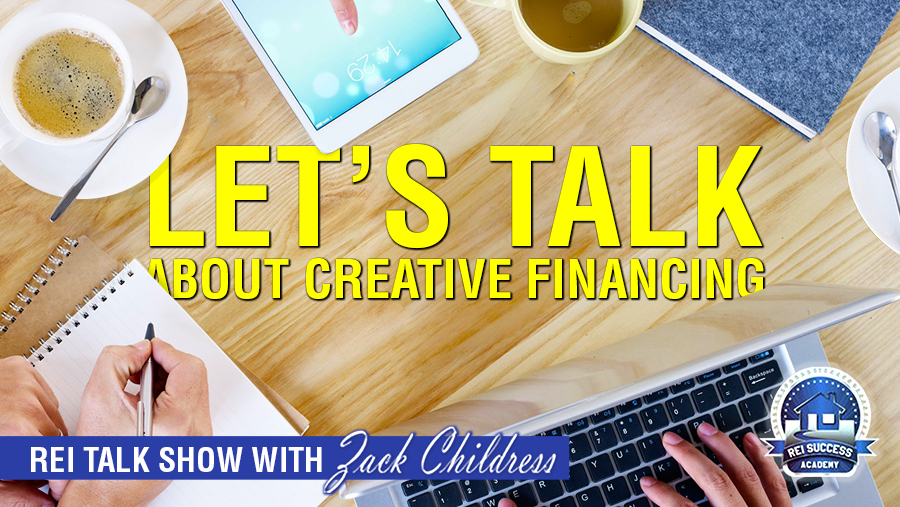
The question that Zack Childress poses in every podcast is how do real estate investors build real wealth and freedom without access to millions of dollars in capital? His mission is to help you find the answer.
Creative financing brings great opportunity. There’s lease option or sandwich lease option, there‘s subject to. Both involve taking over payments from current owner.
With a subject to, I take over the property and take over the payments, but the financing agreement with lender remains in the current owner’s name. The contract states that I pay the owner the payoff amount of loan after ‘X’ number of years.
During those years, I have a renter in the home that’s paying more than the mortgage amount while the final amount due (my final price) continues to go down. I get cash flow and a low price.
Lease option and subject to deals have different contractual requirements. A good real estate attorney is going to know this, but it’s important for you to understand the options so you know the deal’s executed properly.
Wrap mortgage is another approach. It allows you to sell the property with seller financing instead of being a landlord. You charge the buyer a higher interest rate than the property’s existing rate and amortize the loan.
Zack gives a clear explanation of the wrap option. A wrap is a good long-term money maker, so open your mind to this important tool.
Watch and learn:
Listen and enjoy:
What’s inside:
- Zack’s current subject to deal
- Know state and federal laws
- Wrap mortgage option
Mentioned in this episode:
- Reach Zack by phone: 707.247.4248
- Follow Zack on Facebook: REI Success Academy Facebook
- Zack’s Book: My First Deal Playbook
Transcription:
Download episode transcript in PDF format here…
So, the big question is this, how do aspiring real estate investors like us escape from the rat race and build real wealth and freedom without access to millions of dollars in investment capital and start to live the life that we know we deserve? This is the question and this podcast will give you the answer. My name is Zack Childress and welcome to Real Estate Investing Talk Show.
Zack Childress: I do want to talk about creative financing today and why creative financing is one of those things that a lot of people steer away from, but you shouldn’t because there’s so many different ways to do creative financing with sellers. And there’s opportunities out there for you to build cash flow off of properties that you don’t even own. And that’s the beauty of it. You control the property with paperwork that gives you the ability to rent it out, lease it out, sell it out, whatever you choose. You can do so many different things with creative financing. And so, one of those things, if we narrow them down, you’ve got like a lease option, which is leasing the property with the option to buy it. You’ve got the sandwich lease option, which is leasing the property with the option to buy it and then turning around and leasing it to a tenant buyer so that they get the option to buy it.
Zack Childress: And in that aspect, you know, you need a longer term of the lease with the seller, then you would give the term to the buyer, the tenant buyer. Now those using those views in Texas, you may not find a lot of benefit with the lease option just because you guys have regulation over there that kind of restricts the amount of time that you can put on a, on a sale of a lease option. And so, you might lean more towards like a subject to. And there’s nothing wrong with subject tos. I mean, you know, it, it’s just a different way of structuring the deal. So, we’ve talked, you know, lease option is one way to do it. The other way is like a subject to, but a lease option and a subject to both could be taking over payments. I prefer all my lease options to be taking over the payments the same way as if I’m going to do a subject to.
Zack Childress: I’m going to take over the payments and so in a subject to it is what that is. It’s the, it’s a purchase and sales agreement subject to the financing to stay in place and the owner to relinquish title or the deed to the new or to the, to the buyer. So, what does that mean? That means if I’m the buyer and I’m coming in on your property. Well I’m doing one right now, the seller lives in Kentucky and she has a property here in Huntsville and she just doesn’t want anymore. She doesn’t want to manage it from afar. She doesn’t want to deal with it. She just doesn’t want to have anything to do with being a landlord. She wants to go into new ventures in her life. So, I’m putting a purchase and sales agreement with her together. Subject to meaning that she’s going to deed the property to me, whether it be a quick claim deed or anything of that nature and I’m going to take ownership of the asset, but I won’t have ownership of the, the financing, right.
Zack Childress: She will still be responsible legally for the financing. I will have control over the asset though. And the way that works, is it subject to the financing, meaning that the financing is going to stay in place if she owes like 32,000 on the property and I just make a clause in there that just simply says that I am taking over the financing and that my purchase price will be whatever the payoff amount is on the loan at time of close. So, if I take it at 32,000 now and then I’m going to rent it out because her payments like to $280 a month and it rents for $600 a month. I’m just going to take that subject to and turnaround. I’m just going to put a renter in it. I’m going to treat it just like a rental property. And then I’m going to take, you know, the $300 a month off the property because it didn’t have to put any money in the deal, right?
Zack Childress: It’s zero money, zero credit, zero loan at zero qualifications. What I’m going to do with that deal is I’m going to rent it out. So, let’s say over the next 10 years I rent it out, right? So, I’m making $36,000 over 10 years on this property, but in 10 years, is she still going to owe $32,000 on the note? No, she might owe 15,000. The property’s worth about 50,000. So, I’m going to have $35,000 equity built in the property, plus over 10 years I’m going to have about $36,000 in cashflow. So, this little deal over a 10-year period is going to pay me roughly $70,000 over 10 years because then I’ll end up selling it, taking the equity and moving onto a better investment. You know? See, and that’s the good thing about like a subject to, right. Were a lease option, you know, you set the price as is, or you could say in your lease option when it says purchase price, let’s say you agreed on a five year term with them, you know, five year term, you could set purchase price to be the payoff amount of the loan at time of close, so meaning in five years, whatever the balance is on the loan is what you would, what you would have as a payoff amount or a purchase price, but in some cases in a lease option and you’re not really getting that type of flexibility.
Zack Childress: You’re getting, here’s, you know, 35,000 or 135,000 is what I want to sell it for, which means the seller gets the reward in five years from now when you pay 135 and they may only owe 115. So that’s a benefit. So that’s always a good thing. Now the lease option aspect of things is where it’s just a lease with an option to purchase. So, there is no transfer of ownership, there is no triggering of what people refer to as the due on sale clause in the lease options. One of the reasons I love it so much. Now move over to the subject to deal. When we change ownership, could legally there be a due on sale clause executed? Yes, absolutely there could. And in the main way, the main way that that gets triggered is when two main ways when the new ownership, the deed transfer, quick claim, whatever is now in a different form of name and number two, if you try to alter or change the insurance policy. Because if you do that then they notify the lender and the lender goes, oh, but there is a way which is called the St Germain’s Act, which was a federal case that allows us to transfer ownership out of our name into a trust name.
Zack Childress: And so, when we deed a subject to or quick claim it, we never deed into our name. We never deed it into our company name. We always set up a trust. So for instance, you know, like the lady I’m working within Kansas, Kelsey, I would take her last name and I would say her last name, trust, right, like Kelsey’s one, two, three Main Street trust and so therefore it’s got the name and the property address on the trust, even though I am the beneficiary of the trust, but I still want to give her some ownership so I would give her like one percent ownership in that trust. So therefore, she has ownership in the trust. I have majority ownership, but it gives her ownership in the trust. And so that helps you comply with the changing the deed on the property. A lot of people say, yeah, but subject tos, you know, that’ll trigger a due on sale clause.
Zack Childress: Well, it’s just because they’re not educated enough. If you research the St Germain’s Act, which was a federal case, um, it basically allows us to now deed properties into a trust for asset protection and estate planning. So you just got to comply with that. And if you comply with that, then you’re safe. You’re good. You now have ownership in a trust. Now you own the trust, you’re the beneficiary of the trust, you can be the trustee, you can have anybody be the trustee, and now you’re in control of that property and now you can rent it out. You could sell it if you wanted it to, whatever the choice may be at that point. So that’s always good to information. So creative financing is obviously one of those things that you just got to make sure you’re staying in it, you’re learning it, you’re being, you know, active in the process.
Zack Childress: There’s different paperwork involved from, you know, for instance, like a lease option. I’m going to have to file what’s called a memorandum of option to cloud the title so the seller can’t sell it out from underneath me. Were in a subject to their deeding the property into my trust, which means I own it. They can’t sell it. I’m the only one that can sell it. So that gives you protection. Also, you got to think about what’s called an authorization to release information. And so, you know, a lot of times banks will take those, they have to be notarized because why? I need to call the bank, I need to find out really what’s going on with that mortgage, what’s going on with the loan, how, how, you know, where do the payments get sent, things like that. If they have an online log in to their banking mortgage platform, that’s great.
Zack Childress: Because then you can just use that. I’ve done that with properties in the past where I just go online and make the payments. In a lease option you get what’s called an option consideration fee, which is the fee that allows them to take action to purchase. But that option fee is non-refundable. So, you’ve got to have them sign a disclosure that they’re aware of that and they know that. There’re some other things with lease options that you, you need to make sure you’re working with the on the tenant buyer side, on the subject to side, you know, most of the time you could get an authorization to release information. But just to take it one step further, you need to get a limited power of attorney, and that just says, Hey, look, this power of attorney gives me limitations to communicate on the behalf of this property and the information and how this property is acquired, sold, refinance, the whole nine yards.
Zack Childress: It’s a limited power of attorney specifically to that type of property, which gives you the ability to communicate on the behalf of the seller, to the lender, to a closing attorney, to anybody because you have that, you have that document and it needs to be notarized. Okay. So, so there’s, there’s definitely different forms of paperwork that you need to consider when you’re, when you’re moving through that process. On the deal, I’m doing locally, I’m just going to get it subject to and rent it out. Some people want to do a subject to and then you know, and then seller finance it out and do what’s called a wrap mortgage. So, for instance, let’s use Kelsey’s deal. She’s got a five-point four percent interest rate. So, if I take it subject to, I could sell it out on a wrap, but I would need to sell it out for more than five-point four interest rate, right?
Zack Childress: So, I would need to sell it at nine or nine and a half percent. Make the spread on that, amortize that loan for 15 years so that my payment is larger than her 280. Now people say, well, why would you do that? Well, there’s some benefit to that. I can sell it that way. Which means I don’t have to be a landlord, which means I don’t have to fix toilets or trash or broken windows or door knobs that don’t work. I don’t deal with any of that. They got to deal with it. The other side of the equation is if I get it for 32 and I sell it for what it is on the market right now, valued at 55 with a 15-year amortized loan because the payments will be hire. And so, I get the cash flow, and the down payment.
Zack Childress: So what Manny was talking about earlier, the three-way pay on a lease option or subject to, if I’m selling it out, if I’m selling it out on a wrap from a subject to that came in, I get a down payment, which is upfront money. I get the cashflow every month and then I get the back-end payoff once they close on the deal, same way on a lease option. I get the option consideration fee on the front, the cash flow throughout it, and I get the payoff in the back when they close. So, when you’re doing like a subject to, and I’m selling it out on a wrap, I also have to take into consideration what’s called usury laws. And each state is different. Some states say, look, you can’t charge more than 12 percent interest some states so you can’t charge more than 10. And a lot of times that’s based off of.
Zack Childress: They’ll word it like, you can’t charge more than six percent of the prime rate in the current three year, our three-month average or six-month average. And so, let’s say the prime six-month averages, I don’t know, five percent. So then if I can’t charge more than 10 percent, then I can charge prime plus five and I can get my 10 percent. So, there’s a rule of thumb that I know a lot of guys that I network where they do what’s called a 10/10/10 rule. And it’s 10 percent down, 10 percent interest and 10 year amortized. The 10-year amortized just means they’re going to pay it off in 10 years. But it also means that their payment’s going to be a little higher, which creates more cash flow because of a 10-year note. Now the beauty of selling it out on a wrap or a straight seller financing on the outbound side is that you amortize that loan.
Zack Childress: So, for instance, a $55,000 purchase, now, if it was amortized for 15 years, they would end up paying back somewhere around 80 to $90,000 for that property. So, there’s a huge upswing to that, you know what I mean? So where if I’m just renting it, well I could just rent it. And tell them making cash flow and then I could sell it one day or I could rent it and tell the mortgage, got down to maybe say $10,000 on the a to b side where I’m doing the subject to and then I could just pay off the 10,000 now own it free and clear. And then I could just turn around and do a straight seller financing. So, if its own free and clear and I own it free and clear, I can be creative with it. I could sell it on a straight seller financing and I can do a 10, 10, 10, I could do 10 percent down.
Zack Childress: So, let’s say I ride this for 10 years and the property’s worth, I don’t know, let’s just say 65,000 in 10 years from now. And I only owed $10,000 on the mortgage with the original seller. I pay off the $10,000 mortgage. I then turn around to a 10, 10, 10 or I’d probably do a 10, 10, 15, something like that. But let’s just use 10. That means I’m going to get. Now I’ve had it for 10 years, right? I’ve made $36,000 on the cashflow for 10 years. So, let’s just write that out. So that’s 36,000 on that property for the first 10 years. Now I turn around, I asked for 10 percent down, which is 6,500, 10 percent interest rate on this property amortized, which I can pull that up real quick. Let’s see a mortgage, let’s see what the mortgage is going to be. 65,000. 10 percent interest. Ten-year term. That means the payment on this is going to be $690 a month. So, if I take 690 times 12, that’s 8,280 a year. But I’m doing it for 10 years times 10 years, that’s $82,800.
Zack Childress: Oh Boy right. So, here’s where the kids really good. So, I got $6,500 as a down payment. You know what? I forgot to take out the down payment. 6,500. Oh, wait a minute. Sixty 500. Why is it not doing it? $6,500 down payment. Okay, there we go. So, 67, 60, $65,000 mortgage, $6,500 down payment. Which means now I’m financing 10 percent interest 10-year term. My payment is actually, their payment is going to be $777. Dollars month. Isn’t that a beautiful thing? That’s a beautiful thing right there. That’s a beautiful thing. Now here you go. That means over 10 years they will end up paying me back $99,756.
Zack Childress: Yeah. Now you see why you sell on seller financing, right? Times 12. That’s 9,423.00 a year. That’s a big, big win when you do it that way. So. So now I just want you to look. This is a 20-year play. Okay? This is a 20-year play. Remember creative financing. The long term is where the money’s at. It’s not immediate. If you want immediate rewards, wholesale and fix and flip. Long-term play wealth building is through tier two and tier four. So, let’s just look at the 20-year play on this deal.
Zack Childress: Now remember this is a $32,000 property that I’m picking up, okay? $32,000 that I’m picking up. Okay? In 10 years from now on that $32,000 property, I will have made $36,000. Okay? And then pay off $10,000 payoff, okay. Then over the next 10 years that I seller finance it, I’m going to have a $6,500 down payment plus 9,000 or $99,756 in payments, just payments. So, here’s what I want you to understand, on a 32,000 house roughly, I paid $10,000 for it. Over 20 years I will have made you guys are going to love this. I will have made a $142,256 on a $32,000 house that I ended up having a paid $10,000.
Zack Childress: If you remember at the end of 10 years, pay off the mortgage right that I will end up having to pay $10,000 more. So that’s why they say stack these deals, right? Because if you’re stacking these deals right, you’re running yourself into some major prophets, major prophets, I mean think about it, $32,000 house and they ended up making $142,000. But the point being made is that either way you look at it, you can buy $32,000 house and in 20 years, because I’m renting it for the first 10 and then seller financing and out the second 10, I make $142,000 on that deal. So, you know, that’s the beauty. So, if you really wanted to break that down, $142,000 divided by, Oh, am I doing here? $142,000 divided by 20 years, that’s $7,000 a year divided by 12. That’s $600 a month off that property for the next 20 years, right? For the next 20 years, next 20 years. So, and all because what I negotiated some form of creative financing with them. So, you gotta keep that in mind. That’s why I love these deals.
You’ve been listening to the Real Estate Investing Talk Show. I’m Zack Childress and I’m on a mission to create 10,000 real estate bosses over the next year. Will you be one of them?
Head over to my website, ReiSuccessAcademy.com/webclass, and register for my free web class, where you’ll discover how to escape from the nine to five grind and become your own boss in real estate. See you there.









